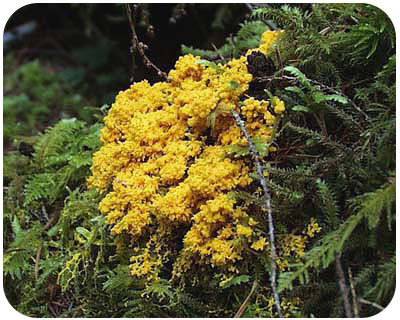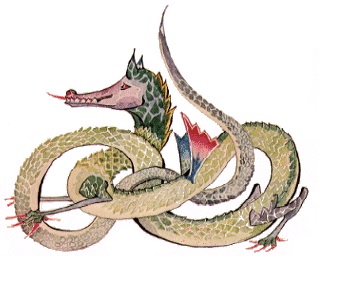I started a new in-person game of 5e D&D with my friends this last Saturday, 13 January, in which I will run
WotC's
Tomb of Annihilation (2017) approximately every other Saturday, while my friend continues running his dungeon on the "off" weekends. So why not title this post "Tomb of Annihilation"? Because I decided to de-emphasize the Tomb's centrality to the game, and focus rather on the jungle hexcrawl--because
that part of the book hooked my interest, while not so much the eponymous tomb.
Because there are only three players, I allowed each to create two characters, and further requested that half the characters be rolled according to +Anders H's "Into the Unknown" a B/X hack of 5e so that we can help playtest the rules (and also because I'm probably just going to run the game like B/X anyway, so it's nice to have a ruleset that backs me up on it). I'd already informed everyone that I'd be changing the XP tables, so they were down with "Into the Unknown" characters too ...
so, our intrepid adventurers:
Sound of Distant Rain (cat-man rogue)
Terahn Atzi (human priest)
Nigiri (lizardman monk)
Takashi Akaga (human magic-user and gourmand)
Nebin (halfling barbarian)
Chiratidzo (human druid)
We started in Port Nyzanzaru somewhat "fresh off the boat" (Chira and Terahn are both Chultan natives, but not well-traveled), and I dropped an info dump on everyone to introduce the game: Chult is a land where death is permanent, regardless of magic--not even a
wish spell can revive a slain character within the bounds of Chult. This has been the case for several generations now, and those who were rich enough and unwilling to live in a land where death was permanent left for other shores when the "death curse" first fell upon the land, but people have been living their lives normally since. No one knows whence this curse has come, but it has lain over the land for some time. (those who are familiar with the adventure will note that I significantly altered the facts here, to de-emphasize the curse as a worldwide "time bomb" and allow more emphasis on hexcrawling)
I also outlined the history of Chult and the war between the city of Mezro and the Eshowe, the rise of Ras Nsi as a lord of undead, and the fact that a dragon turtle called Aremag extorts treasure from ships passing in and out of the Bay of Chult.
And so what were our characters interested in doing? They looked over the hex map I gave them, wondering at all the empty hexes they could explore--but their chief priority was, as players of D&D, to secure some quick money before committing to anything major.
Using his "highborn" background, Terahn secured an audience with one of the local merchant-lords, one
Jessamine, who was rumored to be interested in buying certain flora from the jungle. Jessamine appeared in the courtyard of her villa silently in the midst of the characters, and then proceeded to answer their questions about valuable flora by pointing out that
senda berries and
wildroot are both particularly valuable to her, and there are a few other rare plants that she would pay for.
The party was glad to know this ... hearing that another merchant-lord, one
Jobal, was an outfitter maintaining a stable of jungle guides, they next sought him out and managed to secure an audience with him as well. His villa was filled with trophies of the animals he had hunted and killed, and he immediately hit it off with Chira, not only because Chira was guzzling the proffered palm wine, but also because Chira is a druid and a man of the wilderness. After a few stories about the animals killed (including a "mouth dragon"), Jobal turned to business and counted off a number of guides whose services he could recommend (including a tabaxi pair he is not supposed to recommend--typo number one!--I corrected it later)--but when the party revealed that they did not have the requisite funds for 5 gp/day, 30 day upfront payment (150 gp), the wine stopped flowing. "Come back when you have some coin!" Jobal told them as he sent them out (though not unkindly).
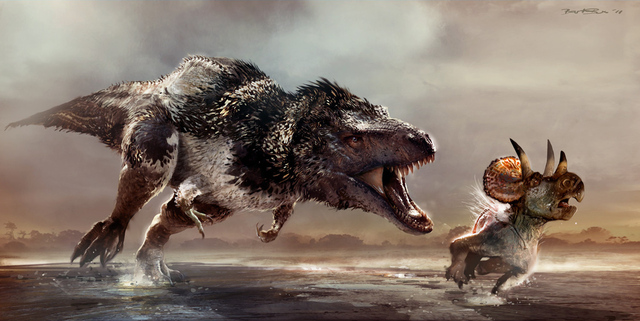 |
| A mouth-dragon pursuing a shield-head |
Now especially in need of funds, the party asked around for quick money and heard that the Flaming Fist regularly supplies Fort Beluarian, a Flaming Fist encampment on the peninsula northwest of Nyanzaru. Rowed galleys carry the supplies across the Bay of Chult to the Fort, and then carry ingots from the mines above the Fort back to Nyanzaru, and the galleys require both rowers and guards/porters out and back.
Odo, quartermaster of the Flaming Fist in Nyanzaru, was approached by Sound of Distant Rain, and offered him and his associates 3 gp/day to act as guards and porters on the next galley.
The galley set out the next dawn; because it wasn't leaving/entering the Bay, it would not be subject to the extortions of Aremag. The first leg of the trip was a short jaunt to a camp on a peninsula halfway between Nyanzaru and the beachhead below Beluarian; on the second day the galley arrived at the beachhead and the supplies were offloaded from the ship; on the third day, the supplies were ported up a path to the Fort itself. The fourth day was slated as a day of rest, and then the last three days of the trip would mirror the first three.
The only encounter seen by the characters on the way out was a flock of scintillating snakes flying through the trees near the beach on the first day.
At Fort Beluarian, after all the porting was done, the characters could rest; Sound elected to gamble with the soldiers of the Flaming Fist (against regulations, but under the noses of their superiors) and won 20 gp after staking a mere 10 gp to start. Nigiri, meanwhile (the lizardman) went forth from the fort and hunted down some local iguanas, herbs, etc., and in-fort cooked up a mouthwatering meal that gathered a number of Flaming Fist soldiers to ask for a portion (they had to jockey with Takasha, the gourmand magic-user who follows Nigiri specifically for his lizardman-cooking).
 |
| Grilled iguanas ... yum! |
The Flaming Fist soldiers then laid out chests of iron and copper ingots stamped with the seal of the Fist, all of which were ported back down to the beachhead and loaded onto the ship; and then the galley set out back for Nyanzaru the next dawn.
On the first day to the halfway peninsula, the ship was buzzed by a flock of pteranodons which ultimately left the galley alone; then later in the day, a band of aarakocra (bird-men) appeared over the galley. These aarakocra were invited down by the characters, and relayed to the party that an injured comrade of theirs was on a beach nearby, having been wounded in a scuffle with lizardmen. The characters arranged for the aarakocra to carry their companion to the ship, there to be healed by a use of
cure light wounds; and when this aarakocra was healed by Terahn, she told the players that her name was
Skir of the Kaaraa Eyrie, and she presented Terahn with her javelin and one of her pinion feathers as tokens of friendship.
Then, on the third day, early in the morning on the beach, the characters were awakened by one of the ship's rowers, one
Osuware. "Quickly!" he whispered, pointing to the treeline and to a flock of iridescent snakes basking in the morning sun in the trees. "Let us take the serpents, and we can sell them back in Nyanzaru!" Most of the party followed; they watched Osuware stuff a serpent into a sack, and then Takasha cast
sleep over the rest of the nine snakes; he then demanded that he receive two of the snakes for Nigiri to cook up for him, while the other eight can be sold, and the party reluctantly agreed.
So, back in town, Osuware guided the party to the villa of
Ifan Tal'Roa, another merchant lord. This Ifan is a great seller of animals, beasts, etc. both as beasts of burden and as creatures bound for gladiatorial games, and he was glad to receive a party attempting to sell him flying snakes. He first offered 25 gp per snake, which Osuware was over-eager to take, and so Sound talked Ifan up to 30 gp per snake. Osuware was glad for it, and, being bad at math, agreed to take 40 gp while the party split the other 200. Ifan advised the party to look out for other beasts in the jungles that he would be glad to buy.
The party then returned to Jobal to get his take on jungle guides; and despite his excessive friendliness now that they were in some money, and despite his protestations
not to seek out his former employees
River Mist and
Flask of Wine, a couple of tabaxi (cat-man) guides who had just broken with him, the party of course, sought out River and Flask. These two agreed to guide the party for a lesser sum of 4 gp/day, with no upfront payment (but they would be glad for a cut of treasure after the fact!). Moreover, they are familiar with the jungle around the River Tiryki, and with two landmarks, one Firefinger (a spire with a ptera-folk tribe) and the other Dungrunglung (a shrine-city of grung frog-men).
 |
| River Mist has the eyepatch; her brother is Flask of Wine |
The party then needed to actually plan their first expedition into the jungles, and ultimately decided to abandon their first plan to seek Camp Righteous and Camp Vengeance on the River Soshenstar, and to follow their guides up the Tiryki River. They bought a rowboat (50 gp) and several weeks of rations, but were confident in their own ability to forage in the jungle for food (and they agreed beforehand to boil their water). Round trip, this expedition is expected to last something like 70 days, most of it the trip there and back, but with a week at the head of the river for in-depth exploration.
We got four days into this seventy day expedition before it was 1:20 am and we needed to break for the night. Each hex on the map is 10 miles across; the travel rules in
Tomb of Annihilation indicate that a party can travel 10 miles in one day, but I find that completely ridiculous for jungle travel; being generous, I cut that in half to 5 miles per day (I would have cut it further, following accounts I've read of jungle travel, but I still want this to be a game ...). I was many beers in at this point, and so didn't roll for the party getting lost, but I did roll all of the encounters for each day--and as a further modification to the rules, I'm going to devise
another table of my own for non-creature "encounters" to roll on once each day, following other tables I've written for other hexcrawls I've run.
Nothing happened on the first day ... on the second day, the party was ambushed by a party of Batiri (jungle-goblins) as they traveled along the banks of the Tiryki. The goblins charged from the bush, but were repulsed by a concerted effort, and when the "boss" was slain, the Batiri rolled poorly on morale, panicked, and ran back into the jungle. From the corpse of the "boss", the party took up a painted mask they think could be worth something back in town, and then they continued on their way south.
On the third day, the party came across a shield-head (or "ytepka" or "three-horns") grazing alone in a meadow not far from the banks of the river. River and Flask were enamored of it, trying to get the party to attack and subdue it so that they could lead it back to town to sell to Ifan Tal'Roa--then they could sell the beast to him for a tidy profit (and only a few days out!) and then restart their expedition with even higher funds. Alas, the party balked at attacking such a large creature, and merely walked around it. Later that day, they provoked a troop of baboons, which attacked them, but were easily driven off with another poor morale roll for the creatures ...
 |
| One ornate species of shield-head |
And on the fourth day, the party encountered a pair of giant spiders, easily dispatched without even the need for a morale roll--and this is where we quit for the night, as it was nigh 2 am and we were semi-incoherent.
So like I said, these encounters need to be spiced up with some non-monster "wilderness encounters" that will vary things beyond mere roleplaying/combat encounters (also, need some roleplaying encounters anyway). The book recommends rolling three times per day; I was thinking of rolling twice on the book's encounter table, and once on my own table each day. Ultimately, this would alter the checks from 3 encounter checks per 10 miles to 4 monster encounter checks and 2 non-monster encounter checks per 10 miles, so I don't feel like it's too much.
The next Chult game will probably be in about two weeks; I'll be sprucing up the hexmap in the meantime and probably sharing ideas and additions here--I admit, I just can't run an adventure/module without tinkering with a fair amount.
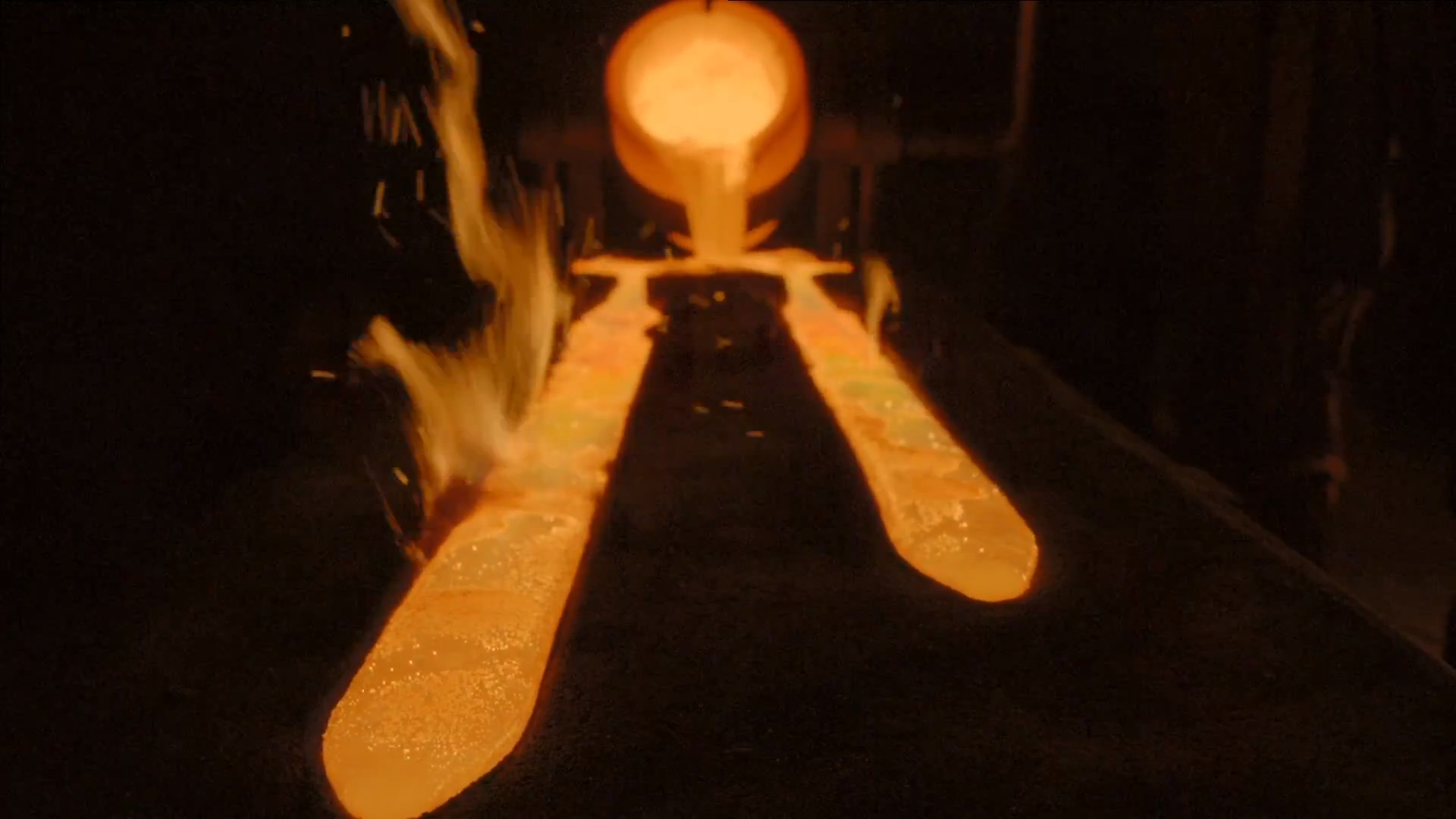
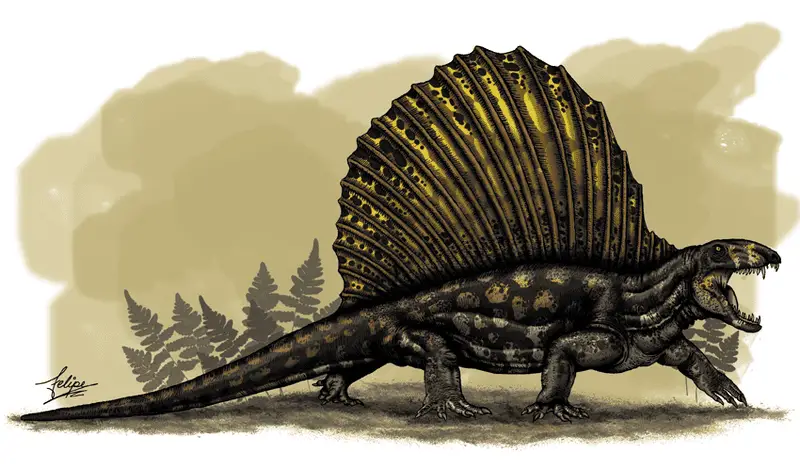



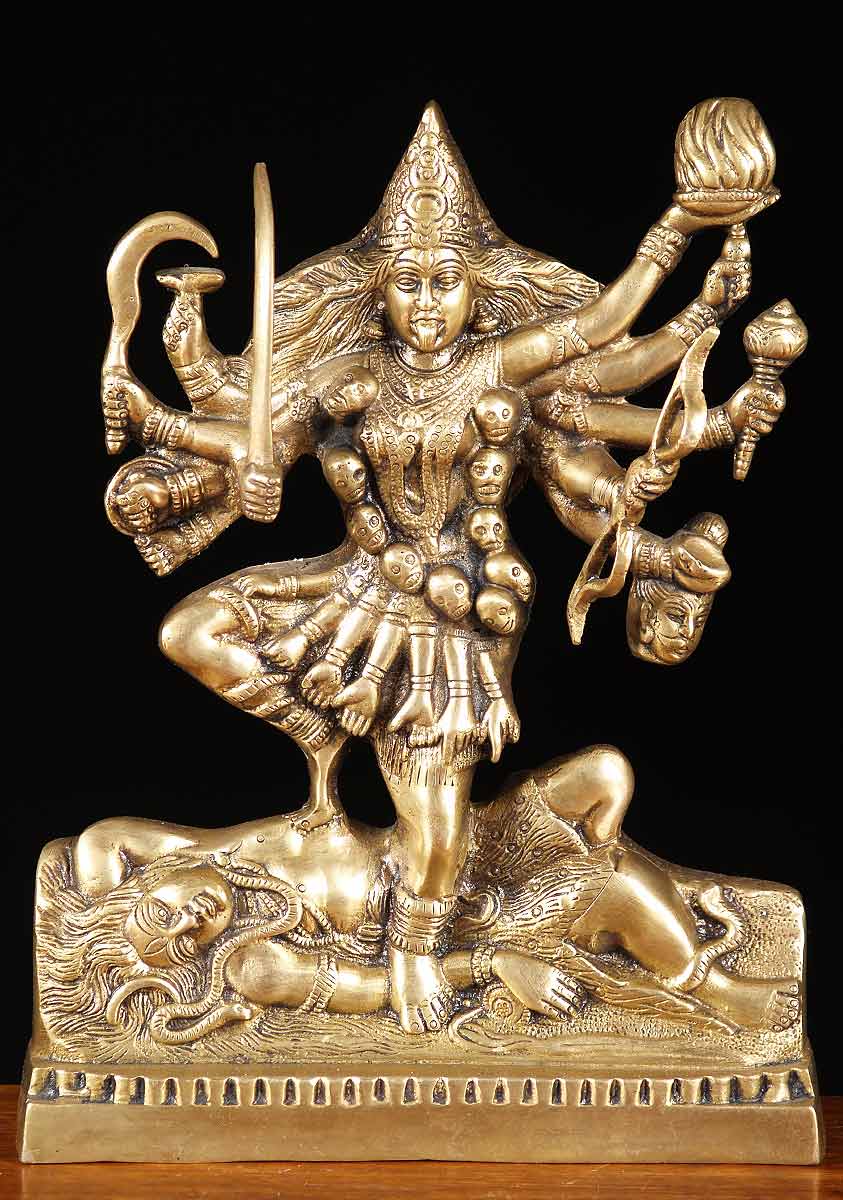


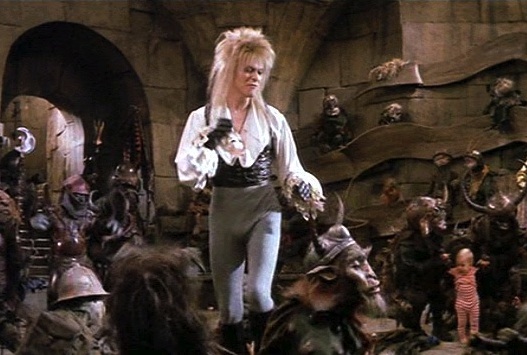

_(18006271698).jpg/800px-Anatomischer_Anzeiger_(1922)_(18006271698).jpg)
